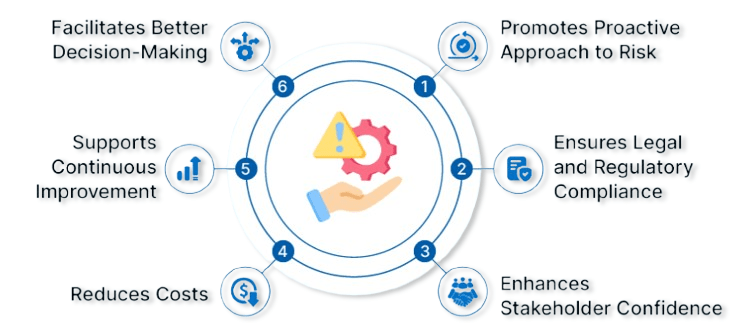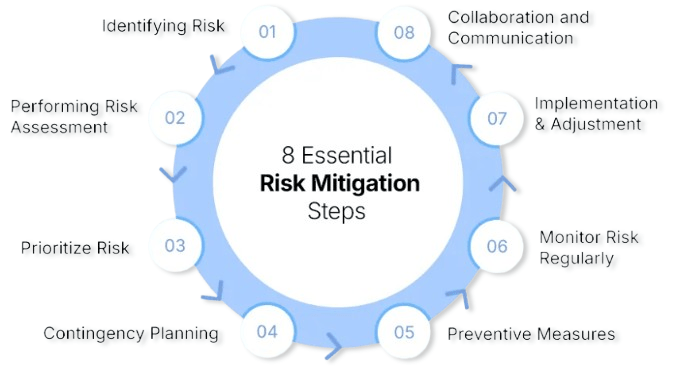
- Introduction
- The Importance of Risk Mitigation
- Risk Mitigation Strategies
- Key Risk Mitigation Techniques for Businesses
- Common Risks Businesses Face
- Risk Mitigation Tools and Techniques
- Measuring the Effectiveness of Risk Mitigation
- Conclusion
Introduction to Program Management
In the modern business landscape, risk is an unavoidable part of operations, affecting companies of all sizes from startups to multinational corporations. However, risks do not have to lead to failure if businesses implement a well-structured risk mitigation plan. Risk mitigation involves identifying potential threats and taking proactive steps to minimize their impact on business functions, finances, reputation, and long-term goals. Effective risk mitigation strategies can vary depending on the nature and scale of the business, but they often include several key techniques. One common approach is risk avoidance, where companies change plans or processes to eliminate exposure to specific threats during Data Science Training. Another strategy is risk reduction, which involves putting controls or safeguards in place to lessen the likelihood or severity of risks. Risk transfer, such as through insurance or outsourcing, shifts the potential burden to a third party. Meanwhile, risk acceptance may be suitable for lower-level risks that are unlikely to cause major disruption. By actively applying these techniques, businesses can improve decision-making, protect resources, and maintain stability in a changing environment. In this blog, we’ll explore these methods in more detail and discuss how your business can build a strong risk mitigation plan for long-term resilience and success.
Would You Like to Know More About Data Science? Sign Up For Our Data Science Course Training Now!
The Importance of Risk Mitigation
The importance of risk mitigation cannot be overstated in today’s dynamic and uncertain business environment. An effective risk mitigation strategy enables organizations to proactively address potential threats, safeguarding their operations, finances, and long-term success. One of the key benefits is the ability to reduce potential losses. By identifying risks early and implementing preventative measures, businesses can avoid or minimize costly financial setbacks that might otherwise derail progress in “ A Day in the Life of a Data Scientist.” In addition to financial protection, risk mitigation plays a vital role in improving decision-making. With a structured approach to assessing and managing risk, leaders can make more informed decisions that align with the organization’s long-term objectives.

Another significant advantage is the ability to protect reputation. Addressing risks before they escalate into crises helps maintain public trust, brand value, and stakeholder confidence. Moreover, effective risk mitigation contributes to ensuring business continuity. With contingency plans and backup systems in place, organizations are better prepared to continue operations even during unexpected disruptions such as cyberattacks, natural disasters, or economic downturns. Overall, a solid risk mitigation strategy not only reduces vulnerabilities but also strengthens a company’s resilience and adaptability in the face of challenges.
Risk Mitigation Strategies
- Risk Avoidance: This involves eliminating activities or conditions that expose the business to risk. By changing plans or discontinuing high-risk operations, companies can completely bypass certain threats.
- Risk Reduction: Businesses can lessen the likelihood or impact of risks by implementing controls such as process improvements, safety measures, or regular maintenance.
- Risk Transfer: Shifting the risk to a third party such as through insurance policies, outsourcing, or contractual agreements can protect businesses from direct impact.
- Risk Acceptance: Some risks are minor and may be accepted without action, especially in Reasons You Should Learn R, Python, & Hadoop.
- Diversification: Spreading resources, investments, or operations across different markets or sectors reduces exposure to any single point of failure.
- Contingency Planning: Having backup plans in place ensures business continuity during unexpected events such as natural disasters, system failures, or supply chain disruptions.
- Regular Risk Assessments: Continually identifying and evaluating new risks allows organizations to stay proactive and update their mitigation plans accordingly.
- Employee Training and Awareness: Educating staff on risk management procedures, cybersecurity, and compliance reduces the chance of human error and strengthens internal controls.
- Thorough Risk Assessment: Begin by identifying and evaluating potential risks across all areas of the business. Understanding the likelihood and impact of each risk helps prioritize which ones need immediate attention.
- Implementing Internal Controls: Establish internal policies, checks, and balances to prevent errors, fraud, and operational failures. Examples include approval workflows, segregation of duties, and audit trails.
- Investing in Insurance: Transferring risk through insurance policies provides financial protection, much like understanding What is Normality Test in Minitab.
- Developing Business Continuity Plans: A strong continuity plan outlines procedures for maintaining operations during disruptions. This includes data backups, alternative suppliers, and remote work protocols.
- Regular Compliance Audits: Conducting routine audits ensures the business adheres to legal and regulatory requirements. This helps avoid fines, penalties, and reputational damage.
- Cybersecurity Measures: Implementing firewalls, encryption, regular software updates, and employee training protects sensitive data and IT infrastructure from cyber threats.
- Supplier and Partner Vetting: Carefully evaluating suppliers and partners reduces the risk of operational disruptions, quality issues, or ethical violations. Contracts should also include clauses that define responsibilities in risk scenarios.
- Risk Management Software: Risk management software helps businesses identify, assess, and prioritize risks. These tools also allow companies to develop and track mitigation strategies in real-time.
- Risk Registers: A risk register is a tool that helps businesses document and track potential risks. It includes details such as the risk’s description, likelihood, impact, owner, and mitigation strategy. It is constantly updated as new risks arise.
- Scenario Planning: Scenario planning helps businesses prepare for uncertain futures by modeling different risk scenarios, such as in the Role of Citizen Data Scientists in Today’s Business.
- Key Risk Indicators (KRIs): KRIs are metrics used to signal increasing risk exposure in specific areas of the business. Monitoring these indicators allows organizations to detect early warning signs and take corrective actions before risks escalate.
- Compliance Management Tools: These tools help ensure businesses adhere to industry regulations and standards. They automate compliance tracking, alert teams to potential violations, and streamline audits, reducing the risk of legal and regulatory penalties.
Do You Want to Learn More About Data Scientists? Get Info From Our Data Science Course Training Today!
Key Risk Mitigation Techniques for Businesses

Common Risks Businesses Face
Businesses today face a wide range of risks both internal and external that can significantly impact operations, profitability, and long-term success. Understanding these risks is essential to implementing effective mitigation strategies that protect the organization. Financial risk includes exposure to currency fluctuations, interest rate changes, or market volatility. Companies can manage financial risk through hedging strategies, maintaining reserve funds, or diversifying their investments to reduce dependency on a single source. Operational risk arises from failures in internal processes, systems, or personnel during Data Science Training. These can be minimized through process automation, the implementation of standard operating procedures (SOPs), routine audits, and performance monitoring. Compliance risk occurs when businesses fail to meet legal or regulatory standards. Staying updated on relevant laws, investing in compliance management tools, and conducting regular audits can help prevent costly legal issues. Reputational risk, often resulting from poor service, negative publicity, or unethical behavior, can be mitigated through transparent communication, prompt customer service, and strong ethical governance. Lastly, cybersecurity risk is increasingly critical. Data breaches and cyberattacks can be avoided by using encryption, multi-factor authentication, timely software updates, and employee cybersecurity training. By recognizing and addressing these key risk areas, businesses can strengthen resilience and ensure sustained growth.
Gain Your Master’s Certification in Data Science by Enrolling in Our Data Science Masters Course.
Risk Mitigation Tools and Techniques
Measuring the Effectiveness of Risk Mitigation
It’s essential for businesses to regularly evaluate the effectiveness of their risk mitigation techniques to ensure they are effectively managing potential threats. Establishing key performance indicators (KPIs) is vital in this process. KPIs provide measurable metrics to track the success of risk management strategies, helping businesses assess whether the intended outcomes are being achieved. If a particular risk mitigation strategy is not reducing the risk as anticipated, it may be necessary to reassess the approach, especially in Why Python Is Essential for Data Analysis & Data Science. This could involve analyzing the underlying causes of the risk, refining the strategy, or implementing new tactics to address the issue better. Periodic evaluations help businesses stay agile, enabling them to adapt to changing circumstances and evolving risks. By regularly monitoring and adjusting risk management efforts, businesses can ensure they are not only minimizing potential disruptions but also remaining resilient and proactive in the face of uncertainty. This ongoing process supports better decision-making, resource allocation, and organizational stability.
Want to Learn About Data Science? Explore Our Data Science Interview Questions & Answer Featuring the Most Frequently Asked Questions in Job Interviews.
Conclusion
Risk is an inevitable part of running a business, but organizations can minimize its impact and navigate uncertainties more effectively with effective mitigation techniques. The first step in managing risk is identifying potential risks, whether financial, operational, strategic, or compliance-related. Once risks are identified, businesses can develop robust risk management plans that outline how to address each potential threat. A comprehensive risk management strategy involves various approaches, such as risk avoidance, where businesses alter plans to avoid risks altogether, and risk reduction, which focuses on minimizing the likelihood or impact of risks during Data Science Training. Risk transfer involves shifting the burden of risk to third parties, such as through insurance or outsourcing, while risk retention is the process of accepting certain risks when the cost of mitigation is higher than the potential impact. By proactively employing these strategies, businesses can not only protect themselves from potential setbacks but also position themselves for growth in uncertain environments. Effective risk management helps ensure stability, supports informed decision-making, and enables organizations to thrive, even in the face of challenges.


